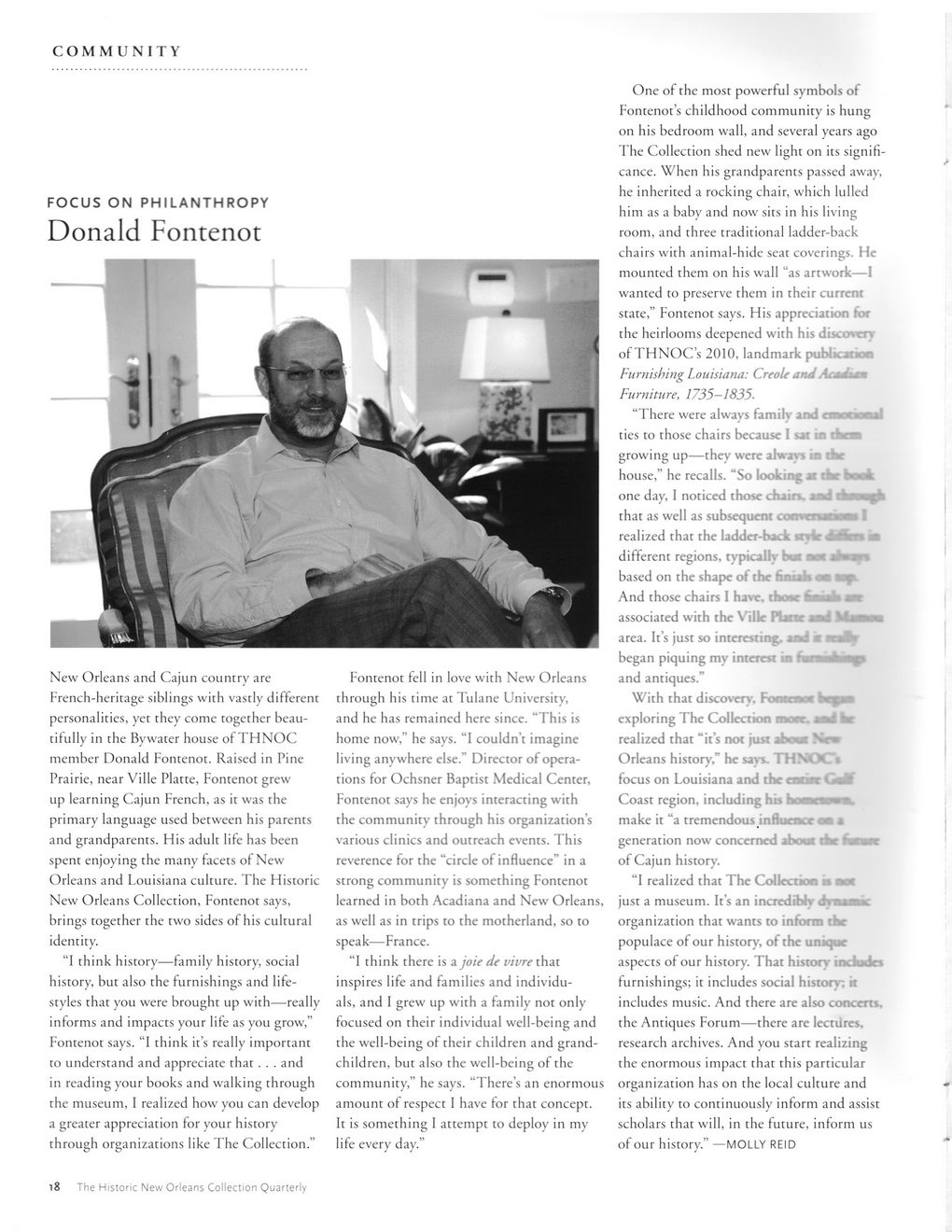This text was obtained via automated optical character recognition.
It has not been edited and may therefore contain several errors.
COMMUNITY FOCUS ON PHILANTHROPY Donald Fontenot New Orleans and Cajun country are French-heritage siblings with vastly different personalities, yet they come together beautifully in the By water house of THNOC member Donald Fontenot. Raised in Pine Prairie, near Ville Platte, Fontenot grew up learning Cajun French, as it was the primary language used between his parents and grandparents. His adult life has been spent enjoying the many facets of New Orleans and Louisiana culture. The Historic New Orleans Collection, Fontenot says, brings together the two sides of his cultural identity. “I think history—family history, social history, but also the furnishings and lifestyles that you were brought up with—really informs and impacts your life as you grow,” Fontenot says. “I think it’s really important to understand and appreciate that . . . and in reading your books and walking through the museum, I realized how you can develop a greater appreciation for your history through organizations like The Collection.” Fontenot fell in love with New Orleans through his time at Tulane University, and he has remained here since. “This is home now,” he says. “I couldn’t imagine living anywhere else.” Director of operations for Ochsner Baptist Medical Center, Fontenot says he enjoys interacting with the community through his organization’s various clinics and outreach events. This reverence for the “circle of influence” in a strong community is something Fontenot learned in both Acadiana and New Orleans, as well as in trips to the motherland, so to speak—France. “I think there is a joie de vivre that inspires life and families and individuals, and I grew up with a family not only focused on their individual well-being and the well-being of their children and grandchildren, but also the well-being of the community,” he says. “There’s an enormous amount of respect I have for that concept. It is something I attempt to deploy in my life every day.” One of the most powerful symbols of Fontenot’s childhood community is hung on his bedroom wall, and several years ago The Collection shed new light on its significance. When his grandparents passed away, he inherited a rocking chair, which lulled him as a baby and now sits in his living room, and three traditional ladder-back chairs with animal-hide seat coverings. He mounted them on his wall “as artwork—I wanted to preserve them in their current state,” Fontenot says. His appreciation for the heirlooms deepened with his discovsrv of THNOC’s 2010, landmark publication Furnishing Louisiana: Creole and Ac*d\ rm Furniture, 1735-1835. “There were always family and cumcknuI ties to those chairs because I sat in Hkh growing up—they were ah*^i in Ac house,” he recalls. “So locking ifct hMfc one day, I noticed those duiiv ud ikMfh that as well as subsequent maun— I realized that the ladder-back tnir iAn m different regions, typically mm liMps based on the shape of the &=ub oa *91 And those chairs I have, ttxy- inli jpk associated with the Ville Pint md Um area. It’s just so interesting, and * began piquing my interest in and antiques.” With that discovery, Fnwnw exploring The Collection mot*. jm4 far realized that “it’s not just abow Nc» Orleans history,” he says. TI 'NtXi focus on Louisiana and thf Coast region, including hit make it “a tremendous influoicf «■ 1 generation now concerned about ifae hcac: of Cajun history. “I realized that The Collet*—u act just a museum. It’s an incredibir organization that wants to inform the populace of our history, of the unique aspects of our history. That history furnishings; it includes social history; k includes music. And there are also concerts, the Antiques Forum—there are lectiires, research archives. And you start realizing the enormous impact that this particular organization has on the local culture and its ability to continuously inform and assist scholars that will, in the future, inform us of our history.” —MOLLY REID 18 The Historic New Orleans Collection Quarterly

New Orleans Quarterly 2014 Summer (18)